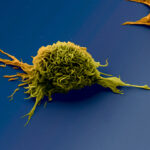Lien vers Pubmed [PMID] – 23690581
Lien DOI – 10.1073/pnas.1307116110
Proc Natl Acad Sci U S A 2013 Jun; 110(23): 9511-6
Drugs of abuse, such as cocaine, induce changes in gene expression and epigenetic marks including alterations in histone posttranslational modifications in striatal neurons. These changes are thought to participate in physiological memory mechanisms and to be critical for long-term behavioral alterations. However, the striatum is composed of multiple cell types, including two distinct populations of medium-sized spiny neurons, and little is known concerning the cell-type specificity of epigenetic modifications. To address this question we used bacterial artificial chromosome transgenic mice, which express EGFP fused to the N-terminus of the large subunit ribosomal protein L10a driven by the D1 or D2 dopamine receptor (D1R, D2R) promoter, respectively. Fluorescence in nucleoli was used to sort nuclei from D1R- or D2R-expressing neurons and to quantify by flow cytometry the cocaine-induced changes in histone acetylation and methylation specifically in these two types of nuclei. The two populations of medium-sized spiny neurons displayed different patterns of histone modifications 15 min or 24 h after a single injection of cocaine or 24 h after seven daily injections. In particular, acetylation of histone 3 on Lys 14 and of histone 4 on Lys 5 and 12, and methylation of histone 3 on Lys 9 exhibited distinct and persistent changes in the two cell types. Our data provide insights into the differential epigenetic responses to cocaine in D1R- and D2R-positive neurons and their potential regulation, which may participate in the persistent effects of cocaine in these neurons. The method described should have general utility for studying nuclear modifications in different types of neuronal or nonneuronal cell types.

